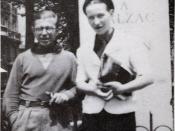We will first discuss what Sartre means by existentialism by expounding his twofold conception of being after which we will undertake his view on imagination and then try to support his view that all authentic works of art are unreal with examples of painting, drama, music e.t.c. This will also substantiate his view that there is no transition between the state of imagination and reality.
Sartre maintains that existentialism is a doctrine that does render human life possible; a doctrine also which affirms that every truth and every action imply both an environment and human subjectivity. In order to expound human subjectivity Sartre starts with a categorical rejection of the traditional philosophical dictum of being and appearances which implied a division and opposition of the same existent. His conception of being has two dimensions- being in itself and being for itself. While the former refers to that aspect of being which by virtue of its being identical with itself is complete and full of existence, the latter because of its complete openness has he ability of receiving existence and transcends being in itself.
However being for itself is completely dependent on being in itself because consciousness cannot arrive in a being without the physical body. It is this consciousness that transcends itself pointing towards a fulfilled being which it never attains and so this fulfillment of a perfect being or a perfect universe can only exist in the imagination, in the world of nothingness which comes with man and the main function of which is to select and render to things which constitute in itself. The same rule applies to the conception of art.
Whether I see or imagine that chair, the object of my perception and that of my image are identical it is that chair of straw...

![[The Voisin brothers, French aviation pioneers. Gabriel Voisin (1880-1973), on the left, and Charles Voisin (1882-1912), on the right] (LOC)](https://s.writework.com/uploads/5/50179/voisin-brothers-french-aviation-pioneers-gabriel-voisin-188-thumb.jpg)
